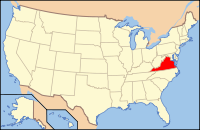Cedar Lee Middle
| Fauquier County, Virginia | ||
|---|---|---|
| County | ||
| Fauquier County | ||

Fauquier County Courthouse in Warrenton
|
||
|
||
 Location in the U.S. state of Virginia |
||
 Virginia's location in the U.S. |
||
| Founded | 1759 | |
| Named for | Francis Fauquier | |
| Seat | Warrenton | |
| Largest town | Warrenton | |
| Area | ||
| • Total | 651 sq mi (1,686 km2) | |
| • Land | 647 sq mi (1,676 km2) | |
| • Water | 3.8 sq mi (10 km2), 0.6% | |
| Population (est.) | ||
| • (2016) | 68,168 | |
| • Density | 105/sq mi (41/km2) | |
| Congressional districts | 1st, 5th | |
| Time zone | Eastern: UTC−5/−4 | |
| Website | www |
|
Fauquier /fɔːˈkɪər/ is a county in the Commonwealth of Virginia. As of the 2010 census, the population was 65,203. The county seat is Warrenton.
Fauquier County is in Northern Virginia and is a part of the Washington metropolitan area. The county is one of the fastest-growing and highest-income counties in the United States.
In 1608, the first European to explore in the vicinity, Captain John Smith, reported that the Whonkentia (a subgroup of the Siouan-speaking Manahoac tribe) inhabited the area. The Manahoac were forced out around 1670 by the Iroquois (Seneca), who did not resettle the area. The Conoy camped briefly near The Plains, from 1697 to 1699. The Six Nations ceded the entire region including modern Fauquier to Virginia Colony at the Treaty of Albany, in 1722.
Fauquier County was established on May 1, 1759, from Prince William County. It is named for Francis Fauquier,Lieutenant Governor of Virginia at the time, who won the land in a poker game, according to legend.
...
Wikipedia

